Blog
Seborrheic Eczema: Conquer Flaky Scalp & Itchy Skin

Seborrheic dermatitis, also known as seborrheic eczema or dandruff, is a common skin condition that causes red, itchy, and flaky patches on the skin. It often affects areas with a high concentration of oil glands, such as the scalp, face, chest, and back.
Causes of seborrheic eczema:
While the exact cause of seborrheic eczema remains a bit of a mystery, researchers believe it’s likely a combination of several factors working together. Here are some of the top contenders:
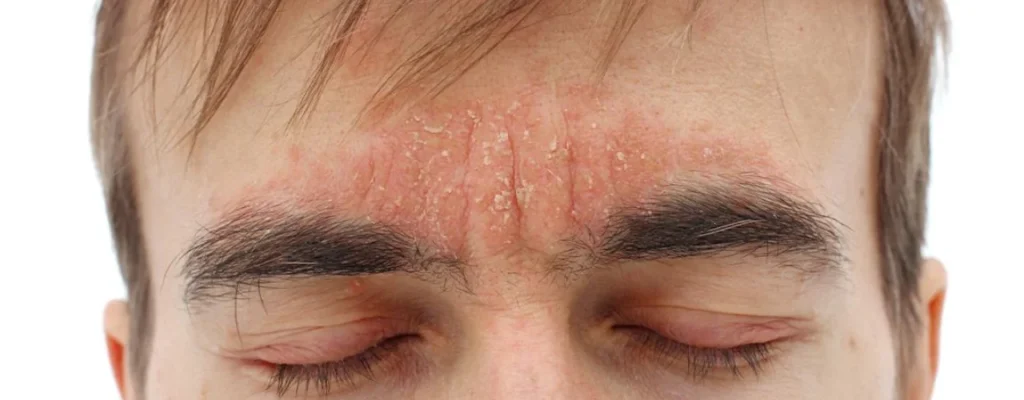
1. Malassezia Yeast: This fungus naturally lives on everyone’s skin, but in people with seborrheic eczema, it seems to overgrow. This overgrowth may trigger an inflammatory response in the immune system, leading to the characteristic symptoms.
2. Genetics: Having a family history of seborrheic eczema or other skin conditions like psoriasis increases your risk of developing it. This suggests a genetic component might be at play.
3. Sebum Production: Sebum is the oily substance your skin produces. People with seborrheic eczema tend to have oilier skin due to increased sebum production. This oily environment can create a more favorable environment for Malassezia yeast to thrive.
4. Immune System: Your immune system’s response to Malassezia yeast plays a role. In people with seborrheic eczema, the immune system seems to overreact to the yeast, leading to inflammation and skin changes.
5. External Factors: Several external factors can trigger or worsen seborrheic eczema symptoms, including:
- Stress: The mind-body connection is strong, and stress can worsen your skin’s condition.
- Weather: Cold, dry weather can exacerbate symptoms, while warm, humid weather might provide some relief.
- Medications: Certain medications, like steroids and lithium, can trigger or worsen seborrheic eczema.
- Medical Conditions: HIV, Parkinson’s disease, and other medical conditions can increase your risk.
Understanding these potential causes can help you manage your seborrheic eczema more effectively. By identifying your triggers and working with your doctor, you can develop a personalized treatment plan to control your symptoms and improve your skin’s health.
Symptoms of seborrheic eczema:
Seborrheic eczema, also known as dandruff or cradle cap, manifests through a variety of signs and symptoms, some common and others less frequent. Here’s a breakdown:
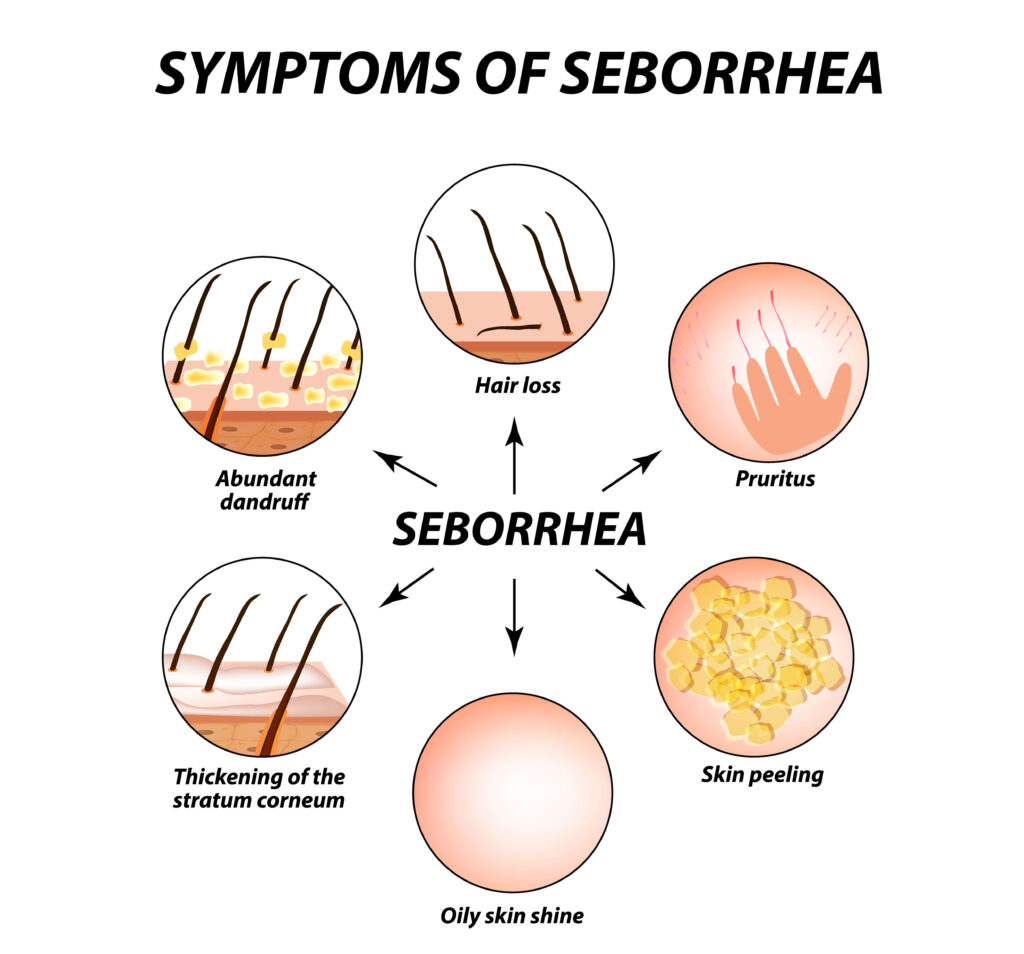
Common Symptoms:
- Flaky skin: This is perhaps the most recognizable symptom, affecting areas like the scalp (dandruff), eyebrows, beard, mustache, and groin.
- Greasy patches: Areas prone to seborrheic eczema often appear oily or greasy alongside the flaking skin.
- Red, itchy patches: Patches of the skin affected by seborrheic eczema will typically be red and inflamed, causing itchiness and discomfort.
- Burning sensation: Some individuals may experience a burning sensation around the affected areas.
- Hair loss: In severe cases, seborrheic eczema on the scalp can lead to temporary hair loss.
Less Frequent Symptoms:
- Blepharitis: Inflammation of the eyelids and eyelashes, causing redness, itching, and crusting.
- Seborrheic dermatitis of the ears: Redness, scaling, and crusting within the ear canal and folds.
- Petaloid seborrheic dermatitis: Ring-shaped, scaly patches with well-defined borders, usually appearing on the chest or back.
- Cradle cap: In infants, seborrheic eczema appears as thick, yellow crusts on the scalp, commonly known as cradle cap.
Important Notes:
- The appearance of symptoms can vary depending on skin tone. On darker skin tones, affected areas may appear darker rather than red.
- Symptoms can worsen seasonally, often flaring up in cold, dry weather and improving in warm, humid environments.
- Stress and certain medications can also trigger or exacerbate symptoms.
If you suspect you might have seborrheic eczema, it’s always best to consult your doctor for a proper diagnosis and to discuss treatment options. Early diagnosis and management can help control symptoms and prevent complications.
Stages of seborrheic eczema:
Seborrheic eczema doesn’t typically have defined stages in the way you might think of with some other skin conditions. However, we can talk about the general progression and severity of the condition:
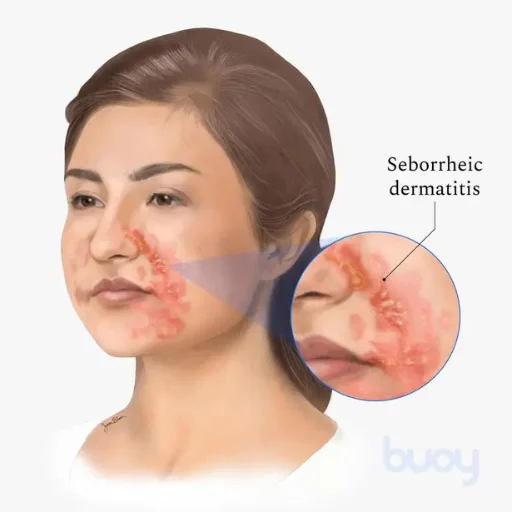
Mild:
- This is the most common form, characterized by:
- Dry, flaky patches, often with an oily or greasy appearance.
- Mild redness and itching.
- Usually localized to small areas like the scalp, eyebrows, or behind the ears.
Moderate:
- Patches become larger and more widespread, affecting areas like the chest, back, and groin.
- Scaling and redness are more pronounced.
- Itching can be more intense and disruptive.
Severe:
- Patches become thick and crusted.
- Inflammation and redness are significant.
- Itching can be severe and lead to scratching and potential secondary infections.
- Hair loss may occur in areas with severe scalp involvement.
Important points to consider:
- Fluctuations: Severity can fluctuate over time, with periods of remission and flare-ups triggered by factors like stress, weather, or medication.
- Individual Variations: The progression and severity can vary significantly from person to person.
- Early Intervention: While stages aren’t strictly defined, seeking treatment early is important to manage symptoms, prevent complications, and improve overall skin health.
Remember, consulting a doctor for diagnosis and personalized management is crucial for effectively controlling your seborrheic eczema, regardless of its severity.
Treatment of seborrheic eczema:
Seborrheic eczema, while having no definitive cure, has a range of treatment options to manage symptoms and prevent flare-ups. The exact approach depends on the severity and location of your condition. Here’s a breakdown of common treatments:
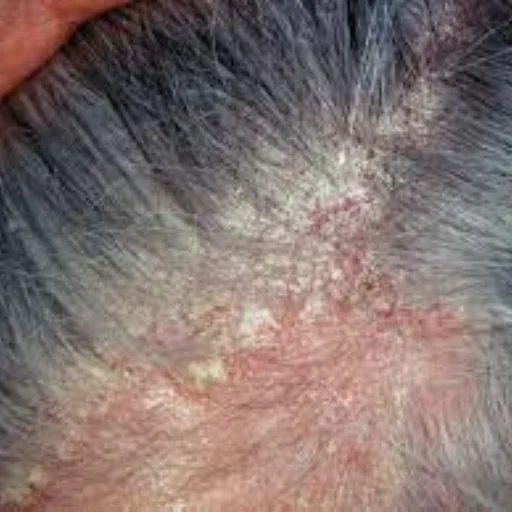
Over-the-counter (OTC) options:
- Medicated shampoos: These contain ingredients like ketoconazole, selenium sulfide, or pyrithione zinc to reduce yeast overgrowth and inflammation. Apply 2-3 times per week for scalp involvement.
- Creams and lotions: Formulated with ingredients like hydrocortisone, ketoconazole, or ciclopirox, these target specific areas like the face, chest, or ears. Apply once or twice daily for short periods to avoid side effects.
- Salicylic acid products: Help soften and remove scales, especially on the scalp. Use sparingly as they can be drying.
Prescription medications:
- Corticosteroids: Stronger creams or ointments for moderate to severe cases. Effective for reducing inflammation but should be used cautiously and for short periods due to potential side effects.
- Calcineurin inhibitors: Alternative to corticosteroids, like tacrolimus and pimecrolimus, they suppress the immune system response in affected areas. Often used for long-term maintenance or for individuals sensitive to corticosteroids.
Light therapy:
- Ultraviolet B (UVB) phototherapy can be helpful for moderate to severe cases, particularly on the scalp. Requires regular sessions at dermatologist’s office or home unit.
https://blog.derma.pk/?s=narrow+band
Lifestyle modifications:
- Stress management: Managing stress can significantly improve symptoms. Try relaxation techniques like yoga or meditation.
- Gentle skincare: Use mild cleansers and moisturizers. Avoid harsh soaps, rubbing, and hot water.
- Diet: While no specific diet cures seborrheic eczema, some research suggests reducing inflammatory foods like refined carbs and sugary drinks might be beneficial.
- Sunlight exposure: Moderate sun exposure can be helpful, but avoid sunburn.
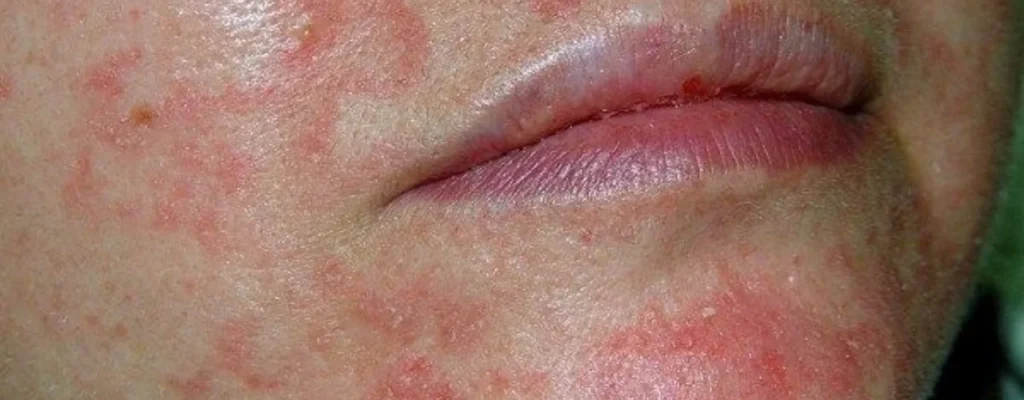
Remember:
- Consult your doctor for a proper diagnosis and personalized treatment plan.
- Stick to your treatment plan consistently for optimal results.
- Identify and avoid triggers that worsen your symptoms.
- Don’t hesitate to discuss any concerns or side effects with your doctor.
By working with your doctor and implementing a comprehensive approach, you can effectively manage your seborrheic eczema and enjoy improved skin health and comfort.
https://blog.derma.pk/?s=eczema
Final Thoughts:
Seborrheic eczema, though not curable, is a manageable skin condition. With a combination of targeted treatments, lifestyle modifications, and understanding of your triggers, you can effectively control symptoms and enjoy clear, comfortable skin. Early diagnosis and consistent management are key.
Derma and Dental Clinic:
Derma & Dental Clinic stands out with its team of experienced doctors backed by scientific evidence in their chosen fields. Their diverse range of medical-grade procedures offer tailored solutions for various skin and dental needs. You can confidently book your consultation online or by phone and embark on your journey towards healthier skin and a radiant smile.
Location: Bahria Town, Lahore
Specialties: Dermatology and Dental Care
Website: Derma.pk
For consultation:
- Online at Dermatology.pk
- WhatsApp: +923205999650
- Phone: 03041115000
Categories
- Accessoreis
- Acne
- Aesthetic Procedures
- Anti Aging
- Author
- Baby Care
- Beauty
- Beauty & Cosmetics
- Blog
- Body Care
- cosmetic procedures
- Dandruff
- Dental Bonding
- Dental Care
- Dental Fillings
- Dental Health
- Dermatologist
- Dermatology
- Doctor
- Downloads
- Eye Care
- Food
- Food and Nutrition
- Hair Care
- Hair Loss Treatment
- Haircare
- Hand and foot care
- Health
- Health and Wellness
- Healthcare
- Imported Products
- Kids and baby care
- Laser Hair Removal
- Lip Care
- Medication
- Men's skin care
- Men's Skincare
- Nail Care
- Nutrition
- Oily Skin
- Online Consultation
- Oral Health
- Personal Care
- Pharmaceuticals
- Procedures
- Products and Ingredients
- scalp care
- Science
- Self care and wellness
- Shampoo
- Skin and Scalp Conditions
- Skin Care
- Skin Care and lifestyle
- Skin care myths and facts
- Skin Treatment
- Skincare
- skincare products
- Smile Design
- sunblocks
- Teeth Whitening
- wellness
- Whitening and brightening















One thought on “Seborrheic Eczema: Conquer Flaky Scalp & Itchy Skin”
Very educating story, saved your site for hopes to read more!